
Presqu'ile (Lyon)
Encyclopedia
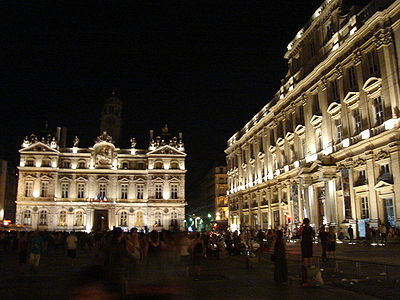
Rhône
Rhone can refer to:* Rhone, one of the major rivers of Europe, running through Switzerland and France* Rhône Glacier, the source of the Rhone River and one of the primary contributors to Lake Geneva in the far eastern end of the canton of Valais in Switzerland...
and the Saône
Saône
The Saône is a river of eastern France. It is a right tributary of the River Rhône. Rising at Vioménil in the Vosges department, it joins the Rhône in Lyon....
rivers, is in the city centre of Lyon
Lyon
Lyon , is a city in east-central France in the Rhône-Alpes region, situated between Paris and Marseille. Lyon is located at from Paris, from Marseille, from Geneva, from Turin, and from Barcelona. The residents of the city are called Lyonnais....
, France
France
The French Republic , The French Republic , The French Republic , (commonly known as France , is a unitary semi-presidential republic in Western Europe with several overseas territories and islands located on other continents and in the Indian, Pacific, and Atlantic oceans. Metropolitan France...
. It has a preponderance of cafés, restaurants, luxury shops, department stores, banks, government buildings, and cultural institutions. The 1st
1st arrondissement of Lyon
The 1st arrondissement of Lyon, France is one of the nine arrondissements of the City of Lyon. It is located below the hill of Croix-Rousse and on the north part of the Presqu'île formed by the Saône and the Rhône, the two rivers in Lyon...
and 2nd
2nd arrondissement of Lyon
The 2nd arrondissement of Lyon is one of the nine arrondissements of the City of Lyon.-History:The first five arrondissements of Lyon were created by the Decree of March 24, 1852, which included the 2nd arrondissement.The current mayor is Denis Broliquier....
arrondissements of the city (as well as the southern part of the 4th
4th arrondissement of Lyon
The 4th arrondissement of Lyon is one of the nine arrondissements of the City of Lyon.-History:The 4th arrondissement of Lyon was created on 24 March 1852 , with the same borders of the old town of La Croix-Rousse.Dominique Bolliet is currently the mayor of this arrondissement.-Streets and...
) are located here, along with the Hôtel de Ville (city hall). The spires of the church of St. Nizier, reconstructed starting in the 14th century, are at the foot of the former Saône river bridge.
This zone is served by the metro lines , and
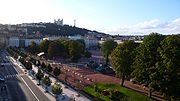
History
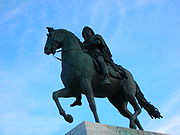
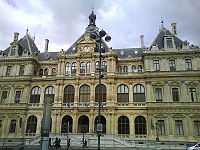


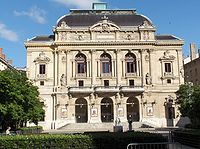

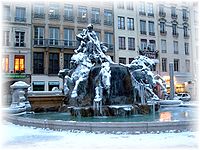
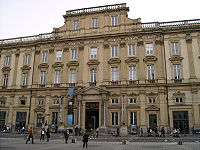

Middle Ages
The Middle Ages is a periodization of European history from the 5th century to the 15th century. The Middle Ages follows the fall of the Western Roman Empire in 476 and precedes the Early Modern Era. It is the middle period of a three-period division of Western history: Classic, Medieval and Modern...
and the Renaissance
Renaissance
The Renaissance was a cultural movement that spanned roughly the 14th to the 17th century, beginning in Italy in the Late Middle Ages and later spreading to the rest of Europe. The term is also used more loosely to refer to the historical era, but since the changes of the Renaissance were not...
. Many picturesque streets still exist. Among these is the rue Mercière, where printers and booksellers gravitated in the 15th and 16th centuries and which still has some superb buildings. The Museum of Printing, housed in the former Hôtel de la Couronne, explains how Lyon’s first books were printed. Squares, in many cases decorated with fountains, and churches sprinkled throughout evoke the presence of numerous convents, including those of the Dominicans (Jacobins
Jacobin (politics)
A Jacobin , in the context of the French Revolution, was a member of the Jacobin Club, a revolutionary far-left political movement. The Jacobin Club was the most famous political club of the French Revolution. So called from the Dominican convent where they originally met, in the Rue St. Jacques ,...
), the Celestines and the Conventual Franciscans (Cordeliers
Cordeliers
The Cordeliers, also known as the Club of the Cordeliers, Cordeliers Club, or Club des Cordeliers and formally as the Society of the Friends of the Rights of Man and of the Citizen , was a populist club during the French Revolution.-History:The club had its origins in the Cordeliers district, a...
), whose Saint Bonaventure church was rebuilt in the 14th century. Further south, the church of Saint-Martin d’Ainay in the Ainay
Ainay
Ainay is an area within the Presqu'ile district in the 2nd arrondissement of Lyon, to the south of Place Bellecour and the north of Perrache. It is best known for its Romanesque church, the Basilica of Saint-Martin d'Ainay. A middle-class area in the city centre, its buildings mainly date to the...
area was originally the church of Ainay Abbey, a large Benedictine monastery, and is still a jewel of Romanesque art in Lyon.
The Place des Terreaux
Place des Terreaux
The Place des Terreaux is a square located in the centre of Lyon, France on the Presqu'île between the Rhône and the Saône, at the foot of the hill of La Croix-Rousse in the 1st arrondissement of Lyon...
was created in the 17th century, owing to the construction of two prestigious structures:
- The Hôtel de Ville, or City Hall, was built between 1646 and 1655 by the architect Simon MaupinSimon MaupinSimon Maupin was a French architect.-Biography:In 1625, he engraved his Plan de Lyon.He became famous when he drew up the plans of the City hall of Lyon, built between 1646 and 1651...
and decorated by the painter Thomas Blanchet. In 1674 the Great Hall was ravaged by fire, and the façade facing the square was redesigned in the early 18th century by Jules Hardouin MansartJules Hardouin MansartJules Hardouin-Mansart was a French architect whose work is generally considered to be the apex of French Baroque architecture, representing the power and grandeur of Louis XIV...
. - The Saint Pierre Palace, formerly a royal Benedictine abbey, was built starting in 1659 by the Avignon architect François Royers de la Valfenière. It now houses the Museum of Fine Arts. The public garden in the former cloister is decorated with the work of famous sculptors and is a quiet, urban oasis. In the 17th and 18th centuries the place BellecourPlace BellecourThe Place Bellecour is a large town square in Lyon, France, to the north of the Ainay district. Measuring 312 m by 200 m , it is the largest clear square in Europe, and the third biggest square of France, behind the place des Quinconces in Bordeaux et the place de la...
was created in honor of King Louis XIV.
Nowadays the Place des Terreaux hosts several restaurants and an impressive statue of a woman on a chariot, and is a common sightseeing destination within Lyon.
Modern times
Germain Soufflot expanded the hospital located near the old Rhône bridge, building the Hôtel-Dieu along the banks of the river. Still a functioning hospital, the Hôtel-Dieu now also houses the Musée des Hospices Civils de Lyon, tracing the history of hospital care in Lyon. Numerous hôtels particuliers were built in the vicinity of the place Bellecour. The Hôtel du Gouverneur, built in 1730, now houses the Musée des Tissus (Museum of Fabric) and the Hôtel de Lacroix Laval, designed by Soufflot, is now the Museum of Decorative Arts. In 1855, during France’s Second Empire period, Claude-Marius Vaïsse, Prefect of the Rhône département, created the rue de la République and the rue Edouard Herriot as part of a series of large construction projects. The Stock Exchange, built in 1860, is an example of the Napoleon III style and is in the heart of the banking district. In the 19th century, two theatres were built: the Célestins Theatre and the Grand Theatre, the latter of which is now the opera houseOpera house
An opera house is a theatre building used for opera performances that consists of a stage, an orchestra pit, audience seating, and backstage facilities for costumes and set building...
, rebuilt in 1993 by Jean Nouvel. These are two of the city’s major cultural centers.
External links
- Informations sur le site Lyon.fr
- Association œuvrant pour la connaissance et la préservation du patrimoine de la Presqu'île
- Site of the Mayor of the second arrondissement
- Hôtels and restaurants
- site tendancepresquile.org
- Site Lyonphotos - The presqu'île under snow
- Lyon : The Presqu'île by vélo'v
- Sur la Presqu'île : some trabouleTrabouleTraboules are a type of passageway primarily associated with the city of Lyon, France, but also located in the French cities of Villefranche-sur-Saône, Mâcon, Saint-Étienne, along with a few in Chambéry)...
s.

